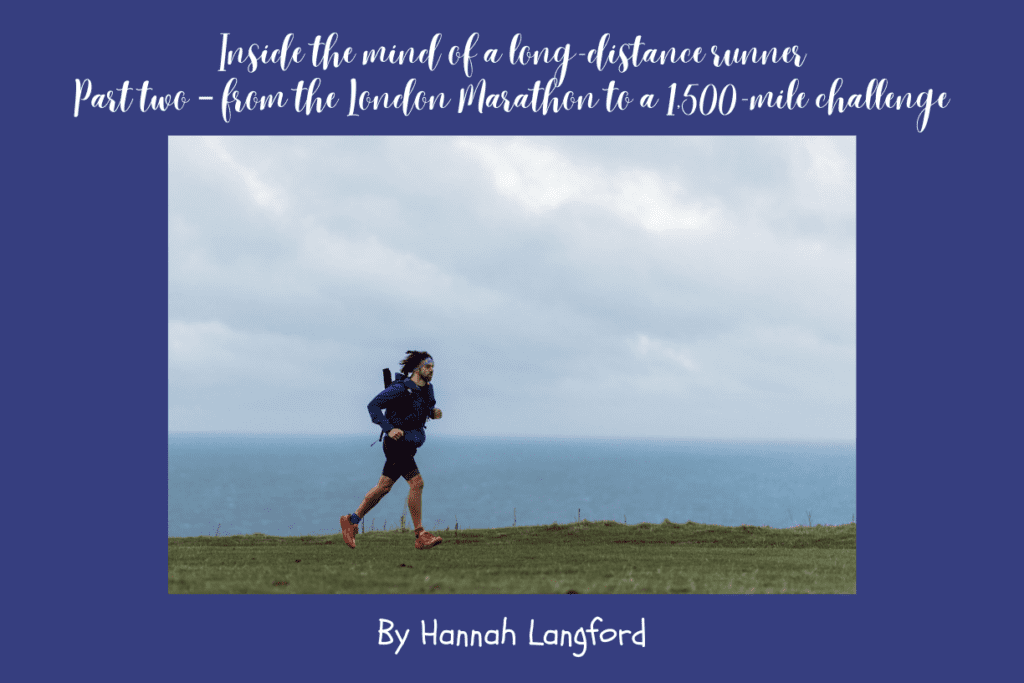Inside the mind of a long-distance runner: part two – essential running kit and why I love long-distance running
We hope the first part of our long-distance running blog made you eager to grab your running shoes!
In part two, Andy Quicke tells us about the next stage of his ‘End-to-End Challenge’. He also explains why he loves long-distance running (and trail running) and shares his advice about the essential long-distance running kit. Getting the right sports shoes for you is a must! Our Bears are always here to give you a helping hand, so don’t hesitate to get in touch.
What is the most recent ‘leg’ of your challenge that you’ve completed?
Between July and now I did a couple of shorter sections with my children in the summer holidays. We covered the area between Falkirk and Glasgow. I ran and they cycled.
No challenge is more important than family, work life or your home life. This way, I have been able to rearrange things without upsetting the apple cart.
What have you got left to do and when do you hope to finish your challenge?
Next weekend I will be doing a 110-mile section of the South West Coast Path, which is part of a race. In January next year I will be doing 100 miles around Land’s End, which is again part of a race (the Arc of Attrition). There will be pretty minimal support for both of those, but one of the upsides is that there will be some company and the logistics are less challenging.
Then I’ve just got to cover the final 200 or so miles. The last stretch is from Shiel Bridge to Cape Wrath in the Scottish Highlands, but I haven’t planned the detail of this part of the route yet. I won’t be able to do that part of my challenge until spring next year as I’m reliant on a ferry and a bus. They only operate from spring onwards, so I will have to wait for a few months to do that.
Of course, it is more efficient to do it all in one go. It will be slower progress and I’ll be fast-packing, either camping or using bothies. Aside from the public transport, the other benefit of waiting until spring is that I will get to experience it in daylight! It won’t be easier, but it will be more memorable. The final stretch to Cape Wrath is the most remote part of the route. It will be nice to see the optimistic signs of regeneration. There might be a bit of blue sky if I’m lucky, but I will be going by the dates and not the weather.
Can you tell me more about your next ‘leg’ (the North Coast 110 Mile Ultra)?
It’s an ultra-marathon between Hartland Quay and Minehead on the South West Coast Path. I’ll be running on coastal paths. It will be slow going and a long 110 miles, but it’ll be fantastic to run along the coastline. When I’ve done coastal runs before, there have been sections where I’ve gone inland and then up and over mountains. It will be a really great sensation to have the sea on my left-hand side for more or less the whole run.
When I’d worked out the whole route for my challenge, I basically happened upon this event, as I hadn’t heard about it before. I incorporated it into my route and ran up to Minehead and then from Hartland Quay. This next ‘leg’ will get me closer to my goal.
What is the best thing about long-distance running?
The ability to go and have an adventure really sets it apart. I don’t want to knock other types of running, as there is a place for everything and different types of running appeal to different people at different times. With long-distance running, you can cover areas with off-road trails and mountains and you get to really experience them. You see the changing of the weather, the seasons and the terrain. You get to see all different aspects of what is out there and you can interact with it. For me it is so much richer than if I just went round a track. It’s also about the people you meet on the way and the variables that you have to adapt to en route.
What is the most challenging thing about it?
I don’t do it because it’s easy! There are the physical, mental and logistical sides, which can all be equally challenging. You have to get yourself from A to B and things don’t always go to plan. You are learning all the time. Food is also a big challenge, as you need to be fuelled with the right things at the right times.
If your route is off the beaten track, then you’ve got to have not just a plan A, but plans B, C, D and E as well! You really have to plan each run in the appropriate way and all these things rolled together make it challenging.
You say that you’ve learnt a lot. What else have you got out of the challenge so far?
It’s the ability to be creative. I’ve never been short of ideas before, but this has required me to keep adapting. In terms of learning points, the Offa’s Dyke section gave me the most. I didn’t know if I’d be able to run long distances again after my injury, so I had to regain my confidence. So much of it is in your mind. I’ve also been treating every section of the challenge as a highlight. I’ve been able to embrace every part of it, which I couldn’t have done if I’d done it on roads.
What essential kit do you need to get started?
You can start off small and add bit by bit, but you do need a good pair of running shoes. The shoes need to be right for you (not anyone else), so make sure you try them out properly. You’ll need a pack that you are comfortable running with (for your food, water and spare kit) and a first aid kit. You might need this either for you or someone else and so it’s also important that you know what to do with a first aid kit.
I recommend starting off with the clothing that you normally run in and adding suitable waterproof and cold weather clothing to your pack. That way, when the conditions change, you can still enjoy your adventures! The team at Running Bear stock a great range of kit and can help you select the right products.
What would your advice be to someone interested in long-distance running?
Find a challenge that is appropriate for you and something that floats your boat. Build up gradually. If there is something that really motivates you, then this is the biggest factor in making it happen. Enjoy your training. There’s no rule book as to how you need to train, so include things that you’d like to do. I’m still doing some races alongside this main challenge. If you make training interesting, then the whole journey will be more rewarding.
UPDATE: Since we spoke to Andy, we are pleased to report that he has successfully completed the North Coast 110 Mile Ultra and so is another step further in his challenge. Well done, Andy!
Thank you very much to Andy for talking to us and we wish him all the best with his ‘End-to-End Challenge’! You can support Andy’s inspirational challenge and the Alzheimer’s Society here.
If this blog has encouraged you to try out a new running challenge of your own, check out these helpful tips from leading wellness professional Adrienne Herbert. You can click here to find out about local running events in your area. Lastly, don’t forget Andy’s advice about the all-important kit that you’ll need before getting started. Visit our shop in Alderley Edge, Cheshire or browse our website to find your perfect long-distance running shoes today!

